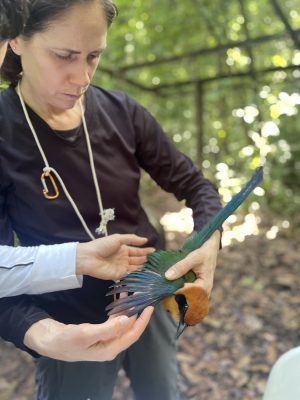A University of Wyoming adjunct professor led a study in a Panama national park that found that nutritional stress, rather than an adaptive response to warming, is more likely the primary cause in the change of tropical birds’ body size.
Additionally, the study found that changes in body size have opposing effects on juvenile recruitment and survival, and no effect on population growth rate, indicating that impacts of changes in body size on bird populations in Panama currently appear to be buffered.

“We found that the impact of changes in birds’ body size on recruitment and survival was variable across species, but those relationships were in the opposite directions. For example, if we saw a positive relationship between body condition and recruitment for a species, then we would see a negative relationship between body condition and survival for that species, ultimately resulting in no change in population growth rate,” says Rebecca Wilcox, an adjunct professor in UW’s Department of Zoology and Physiology and a postdoctoral researcher at the California Academy of Sciences. “This indicates that, at least currently, populations in Panama may be resilient to the effects of changes in body size.”
Wilcox is lead author of a paper titled “Observed declines in body size have different effects on survival and recruitment, but no effect on population growth in tropical birds” that was published in Global Change Biology on Aug. 13. The environmental change journal is dedicated to shaping the future and solving the world’s most challenging problems by tackling sustainability, climate change and environmental protection, food and water safety and provision, as well as global health.
Wilcox, who was a Ph.D. student at UW from 2015-2020, headed the study while she was a postdoctoral researcher collaborating with Corey Tarwater, an associate professor in the UW Department of Zoology and Physiology. Tarwater is the paper’s senior author and runs the long-term study in Panama.
Researchers from the University of Illinois Urbana-Champaign and the Illinois Natural History Survey, which is part of the Prairie Research Institute, also contributed to the paper.
During the study, researchers tracked the presence of 51 year-round resident bird species across 18 families in Parque Nacional Soberania, a 22,000-hectare protected forest in central Panama. Bird species were combined into four feeding guilds: frugivores, nectarivores, omnivores, and insectivores. The study looked at data from 1993-2020.
Of the 51 species examined, 45 species, or 88 percent, showed a decline in body condition across the duration of the study, according to the paper. Of those, the decline was significant for 22 percent, or 11 of the species. Six, or 12 percent of species, showed an increase in body condition but nothing significant, according to the paper.
For wing length, 12 percent of species showed no change; 22 species showed increased wing length; and 23 species saw a decline in their wing length. However, only two species showed a significant change in wing length, with one showing an increase in wing length while the other showed a decrease in wing length. However, the paper concluded wing length had not significantly changed over time for most species.
Precipitation in the dry and wet seasons had different impacts on the body condition of the four bird guilds. Body condition was higher—except for omnivores—when there was more precipitation in the dry season. Guilds also were impacted by precipitation anomalies. Frugivores, nectarivores, and insectivores responded positively to more precipitation anomalies during the wet season, while frugivores and nectarivores positively responded to fewer precipitation anomalies in the dry season.
Changes were stronger and more consistent in body condition and not wing length, which suggests that nutritional stress is the cause of body size declines rather than being an adaptive response, according to the study.
“These results indicate that we should give greater consideration to how indirect biotic impacts—for example, changes in food availability, predators, or parasites—associated with climate change may influence changes in body condition, and that we should not assume that body size is a proxy for fitness,” Wilcox says.
Wilcox says the study’s most interesting finding was that the opposite impacts of body size on survival and recruitment resulted in population growth rates being buffered.
“I think that this result is interesting because it suggests that multiple pathways may counteract each other to weaken any net population-level effect. However, it is important to consider that we don’t know how long the effect of buffering will last,” she says. “Therefore, given that tropical bird populations are generally in decline, and that they continue to face a myriad of threats, such as changing climate and habitat quality, it is important that we continue to monitor these populations to better understand the processes impacting their population dynamics.”
Future studies should not assume that body size is a proxy for fitness. Rather, studies should test for links between body size and demography or consider alternative proxies, Wilcox says. Additionally, she says identifying mechanisms that lead to changes in demography will help researchers understand the processes that influence how populations respond to climate change.
Research funding was provided by the National Science Foundation; the U.S. Department of Defense Legal Resource Program; the U.S. Department of Agriculture’s National Institute of Food and Agriculture; the University of Illinois at Urbana-Champaign; UW; and the Smithsonian Tropical Research Institute.
This story was originally published on UW News.




